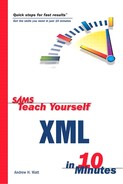XLink Attributes
The XLink specification creates no new elements but does add attributes that are in the XLink namespace to elements in other XML application languages. Typically, the XLink namespace must be declared.
The xlink:href attribute specifies a URI for the remote resource. The type of an XLink—simple or extended—is expressed using the xlink:type attribute. For a simple link that replaces the local resource when the arc is traversed, you need only those two attributes:
<myPrefix:myElement xlink:type="simple" xlink:href="someURI" >
The xlink:show attribute controls where the remote resource is displayed. The default value is replace. To display a resource in a new browser window, the xlink:show attribute has the value new.
The xlink:actuate attribute controls when the arc of the link is traversed. The default value is onRequest. To traverse an arc upon document loading, the xlink:actuate attribute has the value onLoad. At the time of this writing, no browser implements that feature.
An extended link has the xlink:type attribute with the value extended. An extended link may have xlink:href, xlink:show, and xlink:actuate attributes. In addition, it may have xlink:title, xlink:resource, xlink:arc, xlink:arcrole, xlink:label, xlink:from, and xlink:to attributes. The latter attributes will not be discussed further.
